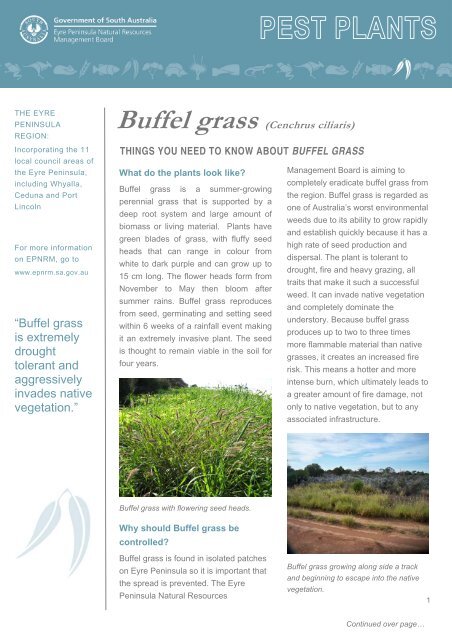Buffel grass - Eyre Peninsula Natural Resources Management ...
Buffel grass - Eyre Peninsula Natural Resources Management ...
Buffel grass - Eyre Peninsula Natural Resources Management ...
You also want an ePaper? Increase the reach of your titles
YUMPU automatically turns print PDFs into web optimized ePapers that Google loves.
THE EYRE<br />
PENINSULA<br />
REGION:<br />
Incorporating the 11<br />
local council areas of<br />
the <strong>Eyre</strong> <strong>Peninsula</strong>,<br />
including Whyalla,<br />
Ceduna and Port<br />
Lincoln<br />
For more information<br />
on EPNRM, go to<br />
www.epnrm.sa.gov.au<br />
“<strong>Buffel</strong> <strong>grass</strong><br />
is extremely<br />
drought<br />
tolerant and<br />
aggressively<br />
invades native<br />
vegetation.”<br />
<strong>Buffel</strong> <strong>grass</strong> (Cenchrus ciliaris)<br />
THINGS YOU NEED TO KNOW ABOUT BUFFEL GRASS<br />
What do the plants look like <strong>Management</strong> Board is aiming to<br />
completely eradicate buffel <strong>grass</strong> from<br />
<strong>Buffel</strong> <strong>grass</strong> is a summer-growing<br />
the region. <strong>Buffel</strong> <strong>grass</strong> is regarded as<br />
perennial <strong>grass</strong> that is supported by a<br />
one of Australia’s worst environmental<br />
deep root system and large amount of<br />
weeds due to its ability to grow rapidly<br />
biomass or living material. Plants have<br />
and establish quickly because it has a<br />
green blades of <strong>grass</strong>, with fluffy seed<br />
high rate of seed production and<br />
heads that can range in colour from<br />
dispersal. The plant is tolerant to<br />
white to dark purple and can grow up to<br />
drought, fire and heavy grazing, all<br />
15 cm long. The flower heads form from<br />
traits that make it such a successful<br />
November to May then bloom after<br />
weed. It can invade native vegetation<br />
summer rains. <strong>Buffel</strong> <strong>grass</strong> reproduces<br />
and completely dominate the<br />
from seed, germinating and setting seed<br />
understory. Because buffel <strong>grass</strong><br />
within 6 weeks of a rainfall event making<br />
produces up to two to three times<br />
it an extremely invasive plant. The seed<br />
more flammable material than native<br />
is thought to remain viable in the soil for<br />
<strong>grass</strong>es, it creates an increased fire<br />
four years.<br />
risk. This means a hotter and more<br />
intense burn, which ultimately leads to<br />
a greater amount of fire damage, not<br />
only to native vegetation, but to any<br />
associated infrastructure.<br />
<strong>Buffel</strong> <strong>grass</strong> with flowering seed heads.<br />
Why should <strong>Buffel</strong> <strong>grass</strong> be<br />
controlled<br />
<strong>Buffel</strong> <strong>grass</strong> is found in isolated patches<br />
on <strong>Eyre</strong> <strong>Peninsula</strong> so it is important that<br />
the spread is prevented. The <strong>Eyre</strong><br />
<strong>Peninsula</strong> <strong>Natural</strong> <strong>Resources</strong><br />
<strong>Buffel</strong> <strong>grass</strong> growing along side a track<br />
and beginning to escape into the native<br />
vegetation.<br />
1<br />
Continued over page…
CONTACT EPNRM<br />
Whyalla<br />
Whyalla City Council Office<br />
Darling Tce.<br />
WHYALLA SA 5600<br />
Tel: 8640 3481<br />
Cleve<br />
25 Fourth Street<br />
CLEVE SA 5640<br />
Tel: 8628 2077<br />
Port Lincoln<br />
23 Napoleon Street<br />
PORT LINCOLN SA 5606<br />
Tel: 8682 7555<br />
Elliston<br />
Elliston Information Centre<br />
ELLISTON SA 5670<br />
Tel: 8687 9275<br />
Ceduna<br />
Shop 7 - Surprys Mall<br />
35 Poynton St<br />
CEDUNA SA 5690<br />
Tel: 8625 3060<br />
Wudinna<br />
Telecentre<br />
44 <strong>Eyre</strong> Highway<br />
WUDINNA SA 5652<br />
Tel: 8680 2901<br />
What are my responsibilities<br />
While buffel <strong>grass</strong> is not yet a<br />
proclaimed plant, its status will be<br />
reviewed by State authorities shortly. It<br />
is likely to be declared a noxious weed<br />
in the near future meaning that all<br />
property owners would have a legal<br />
responsibility to control buffel <strong>grass</strong> on<br />
their property. This also includes<br />
anyone who is leasing property, unless<br />
other arrangements have been made. If<br />
you think you have seen buffel <strong>grass</strong> or<br />
know where an infestation is, please<br />
make sure that you contact your local<br />
NRM office so the locations can be<br />
recorded.<br />
What are the best ways to<br />
control <strong>Buffel</strong> <strong>grass</strong><br />
Once <strong>Buffel</strong> <strong>grass</strong> is established there is<br />
no single control method to successfully<br />
remove infestations.<br />
<strong>Buffel</strong> <strong>grass</strong> being burnt on the Lincoln<br />
highway.<br />
Manual removal of buffel <strong>grass</strong> can be<br />
used for areas were the infestation is<br />
small. Hand pulling or digging out each<br />
clump of <strong>grass</strong> are the most common<br />
methods. Like many plants, any<br />
disturbance of the soil is likely to<br />
stimulate new seedling growth, so care<br />
should be taken when removing plants.<br />
Removed plants may be disposed of by<br />
burning or placing into garbage bags and<br />
disposed of into the normal red lidded<br />
rubbish bin for deep burial at the dump,<br />
to avoid accidental spread of the seed.<br />
Plants may be burnt or slashed to reduce<br />
the biomass and encourage new growth.<br />
This should then be sprayed with a<br />
glyphosate-based herbicide. Local<br />
nurseries can advise you of the<br />
appropriate sprays to use. When using<br />
burning as your control method, contact<br />
the local council first to check on fire<br />
bans.<br />
Using herbicide is a good option for the<br />
control of seedlings rather than mature<br />
plants, which tend to be too large for<br />
spraying to be effective. Always use<br />
herbicide on plants that are green and<br />
actively growing, such as two to three<br />
weeks after a summer rain, which is often<br />
an excellent opportunity to spray targeted<br />
plants. Make sure herbicides are always<br />
used according to the label directions.<br />
The control area should be monitored<br />
during the summer months, so any<br />
emerging seedlings can be controlled<br />
before they produce seed.<br />
For more information on <strong>Buffel</strong> <strong>grass</strong>, contact your local<br />
EPNRM office (see contact details this page).<br />
2
















